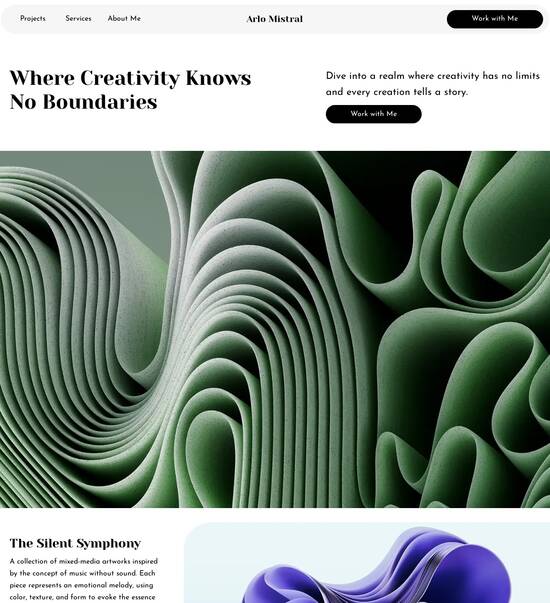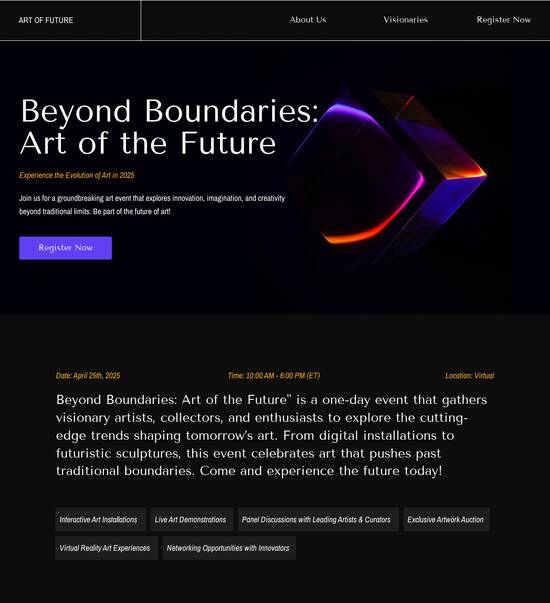
Next.js optimized our team website page template
Explore Similar TemplatesAbout template
Supercharge your our team website page with Next.js for outstanding performance! Learn more today.
Recommended templates

Easy to build without coding
With the intuitive drag-and-drop builder, anyone on your team can create high-converting pages without any knowledge of code or design. Make enhancements to your landing page with custom widgets using Javascript, HTML/CSS, or third-party scripts.

Multiple layouts for any industry and goal
Select from 500+ landing page layouts built to boost conversions across industry-specific scenarios. Customize them by adjusting fonts, adding images, and generating on-brand content with the AI assistant. Quickly scale with Instablocks® and Global Blocks that you can save, reuse, and update globally.

Loads fast and looks polished on any device
Every template is responsive, which means they present professionally on any device and load blazingly fast with our Thor Render Engine. You can also power them up with Google AMP technology to deliver an unparalleled mobile experience and drive higher conversions.

Robust analytics & experimentation
Get real-time updates and reporting across all your devices, showing the number of visitors, conversions, cost-per-visitor, and cost-per-lead. Launch AI-powered experiments, run A/B tests, and use heatmaps to analyze user behavior, then optimize your landing page to maximize conversions.







Easy to build without coding
With the intuitive drag-and-drop builder, anyone on your team can create high-converting pages without any knowledge of code or design. Make enhancements to your landing page with custom widgets using Javascript, HTML/CSS, or third-party scripts.
Multiple layouts for any industry and goal
Select from 500+ landing page layouts built to boost conversions across industry-specific scenarios. Customize them by adjusting fonts, adding images, and generating on-brand content with the AI assistant. Quickly scale with Instablocks® and Global Blocks that you can save, reuse, and update globally.
Loads fast and looks polished on any device
Every template is responsive, which means they present professionally on any device and load blazingly fast with our Thor Render Engine.
Robust analytics & experimentation
Get real-time updates and reporting across all your devices, showing the number of visitors, conversions, cost-per-visitor, and cost-per-lead. Launch AI-powered experiments, run A/B tests, and use heatmaps to analyze user behavior, then optimize your landing page to maximize conversions.
All the features you need to build lead-generating landing pages
Explore more featuresLearn how to build top-performing landing pages for any goal
FAQs
Leading the way in building high-performing landing pages





An effective guide to leveraging Instapage for successful digital campaigns
Instapage stands out as a comprehensive solution for marketers aiming to enhance their landing page and conversion rate optimization (CRO) efforts. By integrating features tailored for diverse audiences in fields such as tech, education, and financial services, Instapage simplifies the process of launching impactful campaigns. This guide will outline how to capitalize on its robust tools to accelerate growth and maximize return on investment (ROI).
Understanding Instapage's offerings
Instapage provides marketers with advanced tools to create landing pages that convert. With access to over 100 high-converting templates, marketers can streamline their campaigns without the need for complex coding knowledge. The platform’s intuitive design tools combined with powerful lead generation elements elevate your digital strategy effectively.
- High-converting templates: Easily customize templates that have been proven to increase user engagement.
- Lead generation elements: Utilize built-in options to capture leads without starting from scratch, enhancing efficiency.
- User-friendly builder: The drag-and-drop functionality allows marketers to design pages quickly, saving valuable time.
Step 1: Creating your landing pages
Begin by selecting a template that aligns with your campaign goals. Customize your landing page using Instapage's intuitive tools to craft a unique experience tailored for your target audience.
- Choose a relevant template: Consider your audience's preferences and behaviors to select an appropriate design.
- Utilize Instablocks: Employ customizable blocks to create diverse page layouts and maintain brand consistency across campaigns.
- Incorporate recordable CTAs: Use compelling calls to action that resonate with users and encourage conversion.
Step 2: Optimize for maximum conversions
Once your landing page is live, utilize the platform's optimization tools to assess its performance. Instapage's built-in A/B testing enables marketers to experiment and iterate their designs based on real-time data.
- Conduct A/B tests: Test different headlines, images, and CTA buttons to determine which combinations yield the best results.
- Analyze heatmaps: Understand user interactions on your page with heatmaps that visually display user activity.
- Use analytics dashboard: Monitor traffic sources and conversion rates to continuously refine your marketing approach.
Step 3: Personalize the user experience
Personalization is crucial in attracting and retaining your audience. Instapage allows you to dynamically replace text and align ads to specific landing pages, creating a tailored experience for each visitor.
- Dynamic text replacement: Automatically adjust page content to reflect the interests and needs of varying audience segments.
- AdMaps integration: Correspond your advertisements with dedicated landing pages to enhance relevance and drive engagement.
- Track audience metrics: Leverage detailed data analytics to assess performance and personalize future campaigns.
To summarize, Instapage is the key to improved marketing outcomes, providing flexibility, insights, and teamwork capabilities that cater to the demands of today's marketplace.
Ready to elevate your digital marketing efforts? Explore everything Instapage has to offer and watch your campaign results soar. Start today and experience the difference in your conversions!
People also ask about Next.js optimized our team website page template
Unveiling the power of Next.js: Optimized team website page template for dynamic experiences
Understanding Next.js in the context of team websites
Next.js is a powerful framework built on top of React that streamlines the process of developing complex web applications. By providing a structure and essential features, it enables developers to create efficient, high-performance team websites. The framework is particularly renowned for its built-in optimizations such as server-side rendering and static site generation, which are crucial for creating a user-friendly web experience.
Using Next.js for team websites is beneficial for several reasons. It allows for cleaner URL structures, automatic code splitting, and enhanced routing capabilities. This means developers can create seamless user experiences without needing extensive custom configurations. Moreover, the framework's focus on optimization directly impacts both performance and search engine optimization (SEO), making it easier for potential clients or partners to discover the team online.
Importance of optimization in web development
Optimization plays a pivotal role in web development, especially for team websites that act as primary touchpoints for potential clients and collaborators. A faster-loading website correlates strongly with better user satisfaction, leading to lower bounce rates and improved visitor retention. Therefore, optimizing the website not only enhances the overall user experience but also significantly boosts user engagement.
From an SEO perspective, optimization is equally important. Search engines prioritize websites that load quickly and provide seamless navigation. Implementing Next.js on a team website enables developers to create SEO-friendly content architecture, ensuring that each page is indexed efficiently and ranks better. This combination of performance and discoverability effectively strengthens the online presence of the team.
Exploring the team website page template features
A well-structured team website page template is essential for showcasing the capabilities and professionalism of a team. Next.js allows developers to build templates that are not only visually appealing but also functionally robust. The template's design philosophy hinges on clarity and ease of navigation, which helps in guiding users through the services offered by the team.
Responsive design is a key aspect of the template, allowing users to access it comfortably on any device, be it a desktop, tablet, or smartphone. This universal accessibility is crucial in catering to a wider audience, as users often switch between various devices. Creating a responsive layout ensures that content remains legible and navigable regardless of screen size.
Core elements of the template
Navigation Bar: A well-structured navigation bar enhances user journeys by providing clear pathways to different sections of the website.
Hero Section: Using captivating visuals combined with concise messaging draws in visitors, conveying the team's mission effectively.
Team Showcase: This area highlights team members with professional profiles, establishing credibility through personal bios and expertise.
Project Gallery: A dedicated gallery displaying past work and case studies emphasizes the team's capabilities and successes.
Testimonials Section: Featuring client testimonials builds trust, as real experiences validate the team's expertise and service quality.
The journey from concept to implementation
Creating a team website with Next.js begins with thorough planning. It's vital to envision the website's goals clearly. This involves discussions with team members to gather insights about the key messages and images that best represent the group. Utilizing user personas can aid in identifying the website's target audience and tailoring the content accordingly.
Equally important is soliciting feedback from stakeholders. This allows for the incorporation of diverse perspectives into the design and functionality of the site. Engaging with various team members can lead to valuable ideas that enhance the user experience. After gathering these insights, developers can begin laying out the initial design framework and selecting the necessary tools to build the template.
Developing the startup landing page template
When developing the actual landing page template in Next.js, leveraging reusable components is key. These components not only speed up the design process but also promote consistency across the website. Reusable components can include navigation bars, footers, and content cards that encapsulate core messages. This method reduces redundancy and streamlines updates when adjustments are necessary.
Customization is another significant aspect when developing the template. While the base design should reflect the team's identity, there should be flexibility in modifying styles, colors, and fonts to align with unique branding. By doing so, each team can maintain its distinct voice while benefiting from the structure and efficiencies provided by Next.js.
Unpacking the user experiences enabled by Next.js
Next.js empowers developers to create websites that integrate interactive and dynamic elements seamlessly. Through the combination of client-side rendering and static site generation, websites can deliver instant feedback to users. This means that interactions, such as filtering team projects or searching for specific information, occur without significant delays, enhancing engagement considerably.
Moreover, client-side fetching of data ensures that visitors receive up-to-date information without needing to refresh the entire page. For instance, when a user navigates to the Projects section, the website can load project details dynamically, thus providing a smooth and uninterrupted browsing experience. This capability fosters deeper connections with users by keeping them engaged with relevant content and interactions.
Effortless navigation with routing capabilities
Next.js offers advanced routing capabilities that simplify navigation through the site. Developers can create route structures that are intuitive, allowing users to move easily from one section to another. This is especially important in a team website where information is spread across various pages, such as profiles, project details, and testimonials.
Furthermore, managing dynamic routes is effortless with Next.js. For example, when a user wants to learn more about a specific team member, the routing feature can handle this by pulling in the individual's information from a predefined dataset. Such dynamic routing enhances the user experience by facilitating quick access to detailed information without unnecessary clicks.
Performance optimization techniques unique to Next.js
One of the standout features of Next.js is its ability to implement server-side rendering. This technique significantly enhances the loading times of web pages, which is especially beneficial for potential customers accessing the team website. By pre-rendering pages on the server, users receive a fully constructed page much quicker than traditional client-rendered pages, positively impacting both performance and SEO.
Alongside server-side rendering, code splitting and lazy loading of components are crucial strategies employed by Next.js. Code splitting allows only the necessary code for the initial render to be loaded, which minimizes initial load time. Meanwhile, lazy loading means that additional resources are only fetched when required. For instance, images in the Project Gallery are loaded as users scroll down, reducing the initial network demands and ultimately improving the user experience.
The role of developers and designers in creating a team website
Creating a successful team website with Next.js requires collaboration between designers and developers. A unified workflow ensures that both the aesthetic design and the technical implementation align seamlessly. Regular meetings and shared tools facilitate this collaboration, allowing for immediate feedback and rapid iterations based on design needs or functional issues.
In this collaborative environment, developers should prioritize best practices for template adaptation. This includes maintaining the website's performance while allowing for customization. Creating clear guidelines can help ensure that any modifications made by team members enhance the user experience rather than detracting from it.
Real-world applications and case studies
Several organizations have successfully implemented team websites using Next.js, showcasing its versatility and effectiveness. For instance, leading tech firms have adopted Next.js for their online platforms to emphasize performance and user engagement. These environments have leveraged the framework's capabilities to create visually appealing sites that load quickly and navigate intuitively.
By examining these success stories, we can glean insights into how well-optimized team websites can enhance online presence. Companies that launched their sites with Next.js reported increased traffic and higher conversion rates, attributing these improvements to the speed and usability of their new platforms. Client feedback highlighted the ease of finding information and the positive impression created by the website's design.
User experiences and feedback
A critical aspect of building a team website is assessing user experiences through data collection and feedback mechanisms. Analyzing visitor engagement, bounce rates, and usability testing can uncover areas for improvement. Teams should actively seek feedback from both users and stakeholders to create a continual improvement loop that enhances the website's features and functionality.
Moreover, incorporating analytics tools can provide valuable insights on how users interact with the site. These tools can track user journeys, revealing the most common entry and exit points, as well as sections that may require optimization. This systematic approach allows teams to evolve their online presence, ensuring the website remains effective and relevant.
Challenges and solutions in building with Next.js
Despite its many advantages, building a team website with Next.js may come with its share of challenges. Common hurdles include navigating complex API integrations and managing different environments, especially as the website grows. These issues can complicate deployment processes and overall development efficiency.
To combat these challenges, teams can employ several proven strategies. Implementing caching mechanisms can help speed up server response times, while employing best practices for API design can streamline integration processes. Additional focus on comprehensive documentation for the development process can also ease transitions and maintenance as team members come and go.
Looking ahead: The future of team websites with Next.js
As web development continues to evolve, Next.js is well-positioned to play a central role in the design and functionality of team websites. Emerging trends such as Progressive Web Apps (PWAs) and Accelerated Mobile Pages (AMP) are expected to shape user experiences further. As these technologies gain traction, they will likely be integrated into Next.js frameworks, providing teams with innovative ways to connect with their audiences.
Additionally, advanced features such as AI-enhanced user interfaces and machine learning algorithms may bring new capabilities to website personalization and optimization. By anticipating these trends and incorporating them into Next.js, teams can remain ahead of the curve, continuously delivering engaging user experiences tailored to their audience's needs.
Integrating advanced features for enhanced functionality
To maximize the advantages offered by Next.js, teams should consider incorporating third-party tools such as A/B testing platforms and heatmap analytics. These tools can provide insights into user behavior, allowing teams to understand what resonates with their audience. As the website evolves, AI-driven personalization can play a crucial role in delivering customized experiences that cater to unique visitor segments.
Ultimately, leveraging Next.js in conjunction with emerging technologies enables marketers and developers to create team websites that are not only visually appealing but also functionally rigorous. This combination positions teams for continued success in their online engagements, fostering improved brand trust and customer loyalty.
Summary of key takeaways
In conclusion, optimizing your team website using Next.js can significantly enhance user experiences and visibility. The template’s structure, responsiveness, and built-in optimization techniques provide an effective foundation for creating a site that is both aesthetically pleasing and functional. Understanding the importance of collaboration among designers and developers further ensures that the website aligns with organizational goals.
As web development continues to advance, embracing tools like Next.js will become increasingly essential. By focusing on performance, user interactions, and ongoing optimization efforts, teams can not only improve their online presence but also maintain a competitive edge in their respective industries.
Ready to skyrocket conversions?
Supercharge your ad campaigns with high-performing landing pages
Get started














